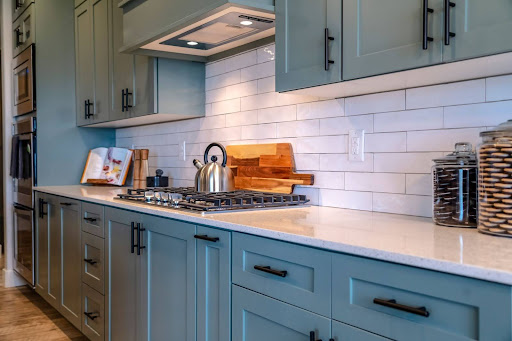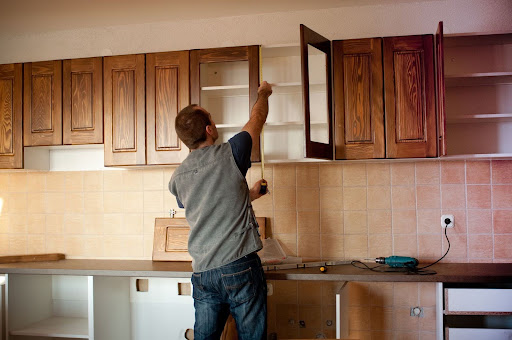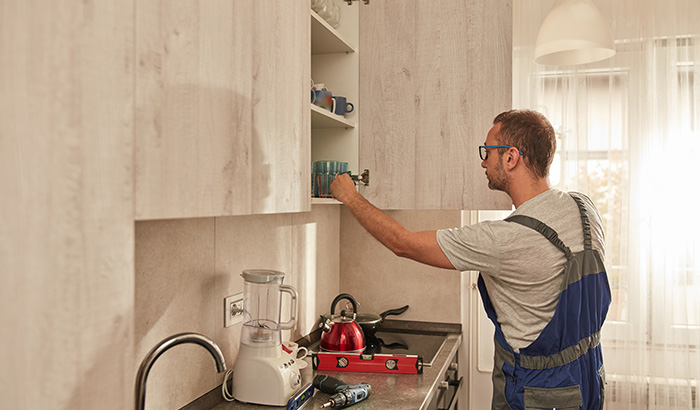Cabinet restoration is a transformative process that changes the look of a whole room. In rooms like kitchens or bathrooms cabinets can make or break the look of the space. Cabinet restoration is one step that will completely revamp a room.
One significant cabinet design trend is blending vintage charm with new-age style. This guide will walk you through the nuances of cabinet restoration, painting, and refinishing, illustrating how to harmoniously mix old with new in your home.
Assessing Your Cabinets: The First Step
Embarking on a cabinet restoration journey begins with a crucial first step: a thorough assessment of your existing cabinets. Before we bring out the brushes and paints or start the refinishing process, take the time to evaluate the condition and style of your cabinets.
This initial assessment is a foundational part of the restoration process that determines the path to take to breathe new life into your cabinets. This initial evaluation will help you decide the extent of restoration needed and the design direction to take.
Look for solid construction, quality wood, and unique design elements that are characteristic of your cabinets. These could be intricate carvings, beadboard panels, glass inserts, or even the way the cabinets are arranged. Details like this inform design choices and give you ideas for restoring your cabinets.
Along with style, it’s good to note the type of wood your cabinets are made from. This plays a significant role in both the restoration process and the final outcome. Different woods respond differently to paint and finishes. For instance, oak, with its prominent grain pattern, offers a different aesthetic and texture compared to the smooth finish achievable on maple or cherry wood.
Once you’ve thoroughly assessed the construction, wood quality, and design elements of your cabinets, we can make informed decisions about the extent of restoration needed and the design direction to take. This could range from a simple repaint to a full-scale refinishing, depending on what your cabinets need and the vision you have for your space.
The Process of Cabinet Refinishing
Cabinet refinishing is a meticulous process that requires attention to detail. At the same time, DIY cabinet restoration can be rewarding. The precision, quality, and durability that professional cabinet restoration services offer can make a significant difference in the outcome of your project.
Cabinet restoration usually starts with stripping old finishes, stains, paint, or varnish. The goal is to make the surface of your cabinets smooth, perfectly even, and ready for the next phase.
After the stripping comes the sanding. Sanding makes sure that the cabinets’ surfaces are perfectly smooth so new paint or finishes will go on evenly and look clean. This is also the stage where scratches, dents, or worn areas are repaired. If you have damaged cabinetry, consider calling a professional so they can repair that damage for you.
Next comes applying the new paint or stain that you want on your cabinets. This is where your vision starts to come to life. You have a lot of options for cabinet finishes, ranging from a matte finish to a high-gloss finish.
If you want to highlight the grain of your wood, then you have staining options as well. Wood stains come in a variety of colors. You can be sure that you’ll find a stain color that matches your creative vision.
After that is done, the next step is to apply the finish and install the hardware. This is when your vision completely comes together and the hard work pays off.
Designing with a Vision: Blending Old and New
Successfully mixing old and new with cabinet restoration lies in striking the right balance in design. This delicate balance is not just about preserving the past; it’s about reimagining it in a new way.
Cabinet restoration offers a unique opportunity to blend the old with the new, creating a space that is both rich in history and steeped in modern style. You can transform your cabinets into a stunning fusion of eras by carefully selecting colors, finishes, and hardware and employing the right refinishing techniques.

The Power of Color in Cabinet Painting
Color is a transformative element in cabinet restoration. You can stain wood cabinets to change the color while showing the grain of the wood, but you can also paint your cabinets for a uniform application of color.
Cabinet painting is perhaps the most dramatic aspect of cabinet restoration. Cabinet painting is a bridge that connects the old world with the new. When selecting colors for cabinet painting, delve deep into the palette to find shades that not only rejuvenate the cabinets but also resonate with other design elements in the space.
Imagine a set of oak cabinets that have stood the test of time — by introducing a modern hue, like a soft gray or a bold navy, we can elevate these cabinets to a level of sophistication that aligns with current trends while maintaining their history. It’s not just about applying a new coat of paint; it’s about crafting a narrative where each brushstroke contributes to the fusion of eras.
The choice of color for your cabinets can significantly influence the overall ambiance of your kitchen or bathroom. A white or light gray, for instance, can open up the room and give it a serene, modern feel, while a dark green or brown can give the room a warm, cozy feel.
Modern color trends lean towards neutral palettes (unless you’re following the maximalism trend), but don’t be afraid to experiment with bold colors if they complement your home’s aesthetic. The key is to choose a color that harmonizes the old with the new, creating a cohesive look. You can do that with colors from any part of the color wheel.
Preserving Structure and Style
While enthusiastically infusing modern elements into your cabinet restoration projects, don’t throw away the original structure and style of your cabinets if you don’t have to. In some cases, they really don’t make them how they used to.
Take advantage of the unique architectural details and the essence of the cabinets and preserve or highlight these elements. They might even inspire other ideas for decorating the room. Preserving and highlighting these details ensures that the end result is not just a standard set of refurbished cabinets but a creative, storied piece of your home’s overall design story.
Refinishing: Updating Finishes and Textures
Cabinet refinishing is another avenue where the old and new can be seamlessly woven together. Updating the finish or texture can complement modern decor while preserving the original structure and style.
Carefully consider how different finishing techniques can enhance the inherent beauty of your cabinets while introducing a modern flair. For example, a matte finish can lend a contemporary feel to the cabinets, offering a subtle yet impactful contrast to the rich, natural wood.
Alternatively, a satin or semi-gloss finish can add a level of sophistication and brightness, making the cabinets stand out in a modern setting.
Refinishing also involves considering the texture — whether to smooth out the surfaces for a sleek look or to retain some of the natural wood grain for character and depth. Whatever your vision for your cabinet’s design, there’s a finish for it.
Hardware: The Finishing Touch
In cabinet restoration, hardware is the final, unifying detail. It’s the finishing touch that brings the entire design together. The hardware you choose can significantly impact the overall look of your cabinet restoration project. Cabinet hardware is usually small, but it makes a big difference.
Traditional hardware styles include intricately designed knobs and pulls, perhaps with an antique finish, that echo the craftsmanship of bygone eras. Modern hardware styles include sleek, minimalist knobs and pulls to add a touch of modern sophistication. These modern elements are characterized by their clean lines and understated elegance.
The contrast between hardware and cabinets can be striking. This kind of contrast in the details often ties everything together. Whether you opt for the elegance of traditional hardware or the simplicity of modern designs, the right choice elevates the entire look of your cabinets.
Consider also hardware that blends the traditional and modern. Try vintage-style handles with a modern finish, such as brushed nickel, or knobs with a contemporary silhouette but a finish similar to wrought iron. When it comes to blending traditional and modern design elements, the possibilities are endless.

Allen Brothers Cabinet Painting: Where Expertise Meets Quality
At Allen Brothers Cabinet Painting, we make sure your cabinets look beautiful, whether they’re new or old. We are in the business of giving you convenient and affordable upgrades for your cabinetry near Bluffdale, Utah.
We believe in offering our customers quality cabinet painting with a tight turnaround; we usually finish our projects in three and a half days! If you’re ready to embark on this journey of transformation, contact Allen Brothers Cabinet Painting or call 801-231-6428 today.

